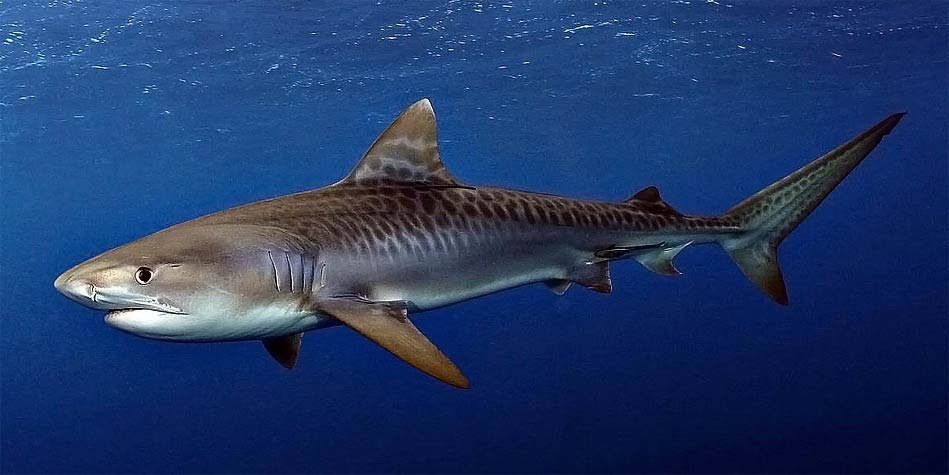Tiger shark – Sea Tiger (Galeocerdo cuvier) – one of the most dangerous sharks
The tiger shark is considered one of the most dangerous sharks in the world – and this is right. It is a very aggressive predator with perfectly heightened senses. Its lust for blood and genetic programming for attacking are the reasons why the prey of these sharks includes not only other animals but even… empty oil barrels.
Classification
- Class: Chondrichthyes
- Order: Carcharhiniformes
- Family: Carcharhinidae
- Genus: Geleocerdo
- Species: tiger shark (Galeocerdo cuvier)
Name
The name of the species comes from dark vertical stripes that young sharks have. With age, the stripes fade away.

Occurrence
The tiger shark is a cosmopolitan species. It can be found in tropical and subtropical waters worldwide. It inhabits the Gulf of Mexico, areas near North America and part of South America. It can also be found in the Caribbean Sea, Africa, the People’s Republic of China, Hong Kong, India, Australia and New Zealand.
Natural environment
The tiger shark is an immigrating species that in cooler, winter months heads for the equator. It can often be found near coral reefs, ports, and canals, which creates a danger for people. These sharks, however, usually swim at the depth of 350 meters (1,150 ft).
The species may be even observed at the depth of 900 meters (2950 ft), but tiger sharks are known for living in shallow waters that might have seemed to be too shallow for fish of such size.
There was even an individual seen in Hawaii that swam 3 meters (10 ft) underwater and in coastal areas that are up to 12 meters (40 ft) deep.

Characteristic features
The tiger shark is one of the largest shark species in the world. Its head is wedge-shaped which enables the animal to make quick turns in every direction. Good maneuvering in the water is enabled by long pectoral fins. The shark makes slight body movements to swim, and thanks to the dorsal fin it can make sudden bursts. It also serves as a pivot that enables the shark to turn around by 360 degrees.
The teeth of this species have a structure allowing detachment of meat, bones, and even turtle shells. As in other sharks, the teeth are replaced with new ones.
The coloration of the tiger shark is a great camouflage – in darker waters in particular. Its skin color may range from blue to light green, with a lighter – white or light yellow belly. As a result, when a shark is under its prey, it is hardly visible in the dark water. When the shark swims above its prey, sun rays falling from the sky are diminished by the light-colored belly.

Senses
The senses of the tiger shark are extremely heightened – as befits every real predator. A reflective layer of the retina, i.e. tapetum lucidum, enables better-capturing photons of light, which, in turn, allows the shark to see better in unfavorable conditions.
Thanks to small pits on the snout, which are called the ampullae of Lorenzini, the shark can detect weak electrical impulses generated by other fish, which is a considerable advantage in the hunt.
Moreover, there is a so-called lateral line on the side of the shark, i.e. a sensory organ, which allows the shark to detect vibrations in the water. It enables finding hidden prey and hunting in the dark.

Diet
The tiger shark is omnivorous, and its menu is almost unlimited. It feeds on fish, shellfish, mollusks, sea birds, jellyfish, sea snakes, dolphins, marine mammals, sea turtles, and even other sharks, including other tiger sharks, which indicates cannibalism.
Tiger sharks also hunt much larger animals, such as whales. An attack of 25 sharks on a sick and injured humpback whale was observed in Hawaii.
Remains of terrestrial animals, such as horses, rats, goats, sheep, dogs, and cats, are often found in tiger sharks’ stomachs. Sometimes, they also eat inedible items, such as empty oil barrels, registration plates or baseballs. Therefore, the sharks are sometimes called the scrapheaps of the oceans.

Reproduction
Females seek mates once every three years. Mating in the Northern Hemisphere occurs between March and May, in the Southern Hemisphere in November, December and January. The tiger shark is the only representative of its family that is ovoviviparous.
Pups hatch in the mother’s body and leave it when they are very well developed. The whole process takes from 13 to 16 months. It comes into the world from 10 to 80 small sharks with a length of 51-104 cm and weighing 3-6 kilograms (6.6 – 13 lb).
Tiger sharks live even up to 50 years.
Tiger sharks and people
Tiger sharks are considered one of the most dangerous species in the world. Although attacks on people are very rare, they are usually fatal. Near Hawaii, 3-4 attacks are noted every year.

Detailed information / size
Tiger shark (Galeocerdo cuvier)
- Sexual dimorphism occurs in tiger sharks, but females are larger – they can be up to 5 meters (16 ft 5 in) long.
- Body length: 3.25–4.25 m (10 ft 8 in–13 ft 11 in), max 5.5 m (18 ft 1 in)
- Newborn: 51–76 cm (20–30 in)
- Weight: 385–635 kg (849–1,400 lb), record 1,524 kg (3,360 lb)
- Lifespan: to 50 years
Due to its size, the tiger shark can compete with another large species – the great white shark.

Tiger shark – interesting facts
- A female tiger shark was entered into the Guinness Book of Records due to her length of 5.5 meters (18 ft 1 in) and weight of 1524 kg (3,360 lb) – she was most likely pregnant at that time. While the female caught in 1957 had measured 7.4 meters (24 ft 3 in) and weigh 3,110 kilograms (6,856 lb). This data, however, has never been confirmed.
- The tiger shark is an attraction in recreational fishing.
- Frequently it is caught also for the oil produced by its liver. It is widely believed that the oil contains a lot of vitamins.
- Although these sharks swim very slowly – making it even harder to notice them in water, they can immediately accelerate. Their prey does not have time to escape.
- The International Union for Conservation of Nature classified the tiger shark as a near-threatened species.

Recommended
- Marine
- Sharks – myths and facts
- Sharks – killers from the depths
- Great white shark
- Megalodon
- Whale shark – largest fish
- Basking shark – the second largest fish
- Greenland shark
- Hammerhead shark
- Longest whales
- Heaviest whales
- Largest sharks
- Extinct animals
- Animal fights
- American lion
- European cave lion
- Smilodon – Saber-toothed tiger
- Fastest animals
- Fastest birds


















